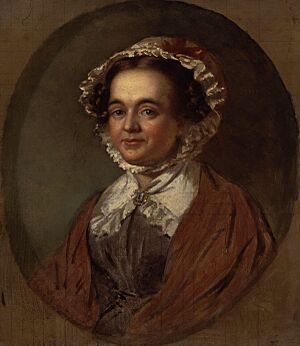Mary Russell Mitford facts for kids
Quick facts for kids
Mary Russell Mitford
|
|
|---|---|

Portrait of Mary Russell Mitford by Benjamin Robert Haydon, 1824
|
|
| Born | 16 December 1787 New Alresford, City of Winchester, England |
| Died | 10 January 1855 (aged 67) Swallowfield, Berkshire, England |
| Occupation | Novelist |
Mary Russell Mitford (16 December 1787 – 10 January 1855) was an English essayist, novelist, poet and dramatist. She was born at Alresford in Hampshire. She is best known for Our Village, a series of sketches of village scenes and vividly drawn characters based upon her life in Three Mile Cross near Reading in Berkshire.
Contents
Childhood
She was the only daughter of George Mitford (or Midford), who apparently trained as a medical doctor, and Mary Russell, a descendant of the aristocratic Russell family. She grew up near Jane Austen and was an acquaintance of hers when young. At ten years old in 1797, young Mary Russell Mitford won her father a lottery ticket worth £20,000, but by the 1810s the small family suffered financial difficulties. In the 1800s and 1810s they lived in large properties in Reading and then Grazeley (in Sulhamstead Abbots parish), but, when the money was all gone after 1819, they lived on a small remnant of the doctor's lost fortune and the proceeds of his daughter's literary career. He is thought to have inspired Mary with the keen delight in incongruities, the lively sympathy, self-willed vigorous individuality, and tolerance which inspire so many of her sketches of character. She cared for her mother and father until their deaths and supported them and herself by proceeds from her writing.
From age 10 to 15 she attended a school in Hans Place, Knightsbridge, London, the successor to Reading Abbey Girls' School, which Austen had attended a few years earlier. Her father engaged Frances Arabella Rowden, formerly governess to the family of Frederick Ponsonby, 3rd Earl of Bessborough, to give her extra tuition. Rowden was not only a published poet, but according to Mitford, "she had a knack of making poetesses of her pupils". Rowden took Mitford to Theatre Royal, Drury Lane, especially to plays featuring John Kemble, and entranced her with the life of the theatre.
Works
Mitford's youthful ambition had been to be the greatest English poetess, and her first publications were poems in the manner of Samuel Taylor Coleridge and Walter Scott (Miscellaneous Verses, 1810, reviewed by Scott in the Quarterly; Christina, the Maid of the South Seas, a metrical tale based on the first news of discovery of the last surviving mutineer of the H. M. S. Bounty and a generation of British-Tahitian children on Pitcairn Island in 1811; and Blanche, part of a projected series of "Narrative Poems on the Female Character", in 1813). Her play Julian was produced at Covent Garden, with William Charles Macready in the title role, in 1823; Foscari at Covent Garden, with Charles Kemble as the hero, in 1826; while Rienzi, 1828, the best of her plays, ran for 34 performances, and Mitford's friend, Thomas Noon Talfourd, supposed that its popularity detracted from the success of his own play, Ion. Charles the First was refused a licence by the Lord Chamberlain, but was played at the Surrey Theatre in 1834.
The prose, to which she was driven by the need to earn a living, was the most successful and financially rewarding of her literary productions. The first series of Our Village sketches appeared in book form in 1824 (having first appeared in The Lady's Magazine five years previously), a second in 1826, a third in 1828, a fourth in 1830, a fifth in 1832. They were reprinted several times. Belford Regis, another series of literary sketches in which the neighbourhood and society of Reading were idealised, was published in 1835. Her description of village cricket in Our Village has been called "the first major prose on the game".
Her Recollections of a Literary Life (1852) is a series of causeries about her favourite books. Her talk was said by her friends, Elizabeth Barrett Browning and Hengist Horne, to have been even more amusing than her books, and five volumes of her Life and Letters, published in 1870 and 1872, show her to have been a delightful letter-writer. The many collections available of her letters provide especially useful commentary and criticism of her Romantic and Victorian literary contemporaries.
Later life and death
Mitford met Elizabeth Barrett Browning in 1836 and their acquaintance ripened into a warm friendship.
The strain of poverty told on Mitford's work, for although her books sold at high prices, her income did not keep pace with her father's extravagances. In 1837, however, she received a civil list pension, and five years later, on 11 December 1842, her father died. A subscription was raised to pay his debts, and the surplus increased Mary's income.
In 1851 she moved from Three Mile Cross to a cottage in Swallowfield, three miles away, where she remained for the rest of her life. She died there on 10 January 1855, after being injured in a carriage accident the previous December. She was buried there in the churchyard.
Legacy
Her life was dramatised in the 1940 Australian radio play Three Mile Cross by Catherine Shepherd.
See also
 In Spanish: Mary Russell Mitford para niños
In Spanish: Mary Russell Mitford para niños

